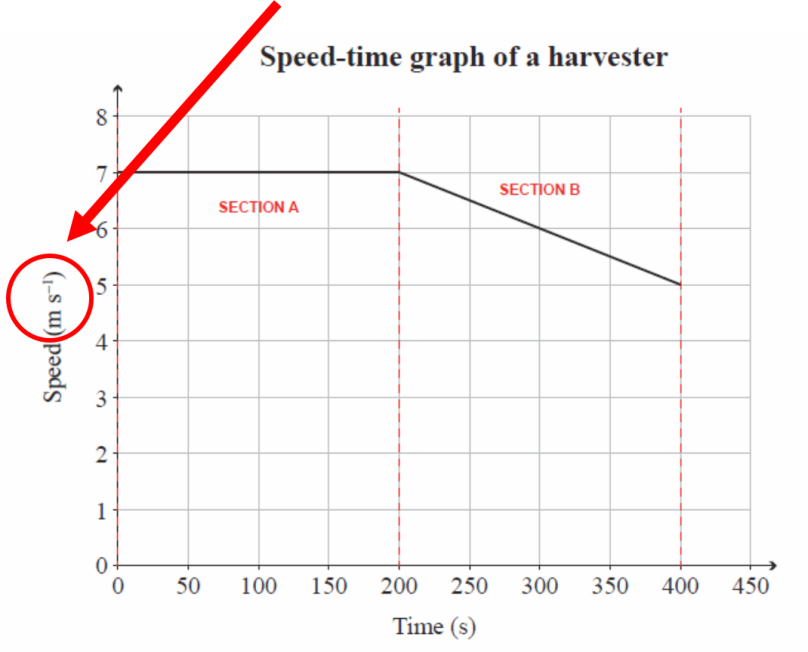Until recently I wasn’t worried. If anything I tended to side with “ms-1“. Why? It just seems more hi-tech, even sexier. “m/s” just seems old fashioned. “ms-1“ is what the scientists use. It’s certainly what the Year 11 General Science exam uses…

So I went with “ms-1“. Of course I prefaced this by showing my kids the mathematical equivalence between the two. But, once that was out of the way, I was determined that “ms-1” had exclusive use in my classroom to prepare my kids for the end of year exam.
However, in the last few years, although I agree both m/s and ms-1 are mathematically equivalent I have come to believe that m/s is a far superior unit for our students. Let me try and convince you.
My main argument here can be summed up by saying both of these units out loud: “metres per second” compared to “m s negative one“.
There is an entire branch of learning science that studies the link between how we use language, and how we think: cognitive linguistics. These cognitive scientists argue that “symbols are, of course, just symbols, not ideas. The intellectual content of mathematics lies in its ideas, not in the symbols themselves. In short, the intellectual content of mathematics does not lie where mathematical rigor can be most easily seen – namely, in the symbols. Rather it lies in human ideas”. [Lakoff, Nunez. Where mathematics comes from].
Cognitive linguists analyse language, and language is really a window to our brain. Its a way we can see how students are thinking. What are students thinking when they say “metres per second“? What about “m s negative one“?
I think a better question is what idea are students attaching to the symbol/unit when they say “metres per second” or “m s negative one“?
I would argue that more students are attaching the correct concept of speed when they say “metres per second” than “m s negative one“. In fact, I would argue for many students, “m s negative one” just becomes a slogan, with no meaning, or idea attached.
Here is a video I often show my kids for a laugh. It’s probably staged, but listening to the lady’s use of language (she often says “mph” instead of “miles per hour”), it gives us a window into how she understands (or misunderstands) the concept of speed.
Physics education research has shown that many students, although capable of numerical calculations, have no idea of the concept of speed. How? They often mix up position and speed (that is if two objects have the same position, they must have the same speed).
Therefore we need to use every opportunity we have to help our kids to understand speed. And using “m/s” instead of “ms-1” is a great start.
And there are other educators that go further. They argue that the word “per” has no meaning for students. We should replace “per” with “for every” in our classroom language. Therefore these teachers would argue “metres for every second” > “metres per second” > “m s negative one“. I have tried to encourage my kids to use “for every” much more in classroom discussions.
This year I did a bit of an informal experiment with my year 10 science class (caveat: they are the top class). We did a large physics unit (the whole of term 1) on velocity, acceleration and energy. How did I stretch it that long? We dived deep into pictorial representations of these concepts (graphs, motion maps, energy bar charts), did a number of experiments, and (tried to) facilitate whole-class discussions on these concepts.
Interestingly, I never taught, and these student’s never saw, the standard formula for speed/velocity (speed=distance/time). And yet nearly every single one of these 14 year olds had no trouble answering this question on their end of topic test:
Who runs faster? Elle ran 100m in 12 seconds. Karsen started 20 m in front of her, and ran the remainder of the 100m in 10 seconds. (Show calculations that lead to your answer).
I like to think this was possible because these students had a solid grasp of what the concept of speed/velocity is, and a large part of that was these student’s continually using the language of “metres per second“.
If NZ teachers ever get a chance to have input into a change of our NCEA standards/exams, then we need to be thinking more than just what content we cover. After all, much of our teaching is guided by the exams. When writing these these exams, exam writers shouldn’t ignore subject specific pedagogy. That is, how students actually learn science. I think in the case of “m/s” vs “ms-1“, more thought needs to be given.